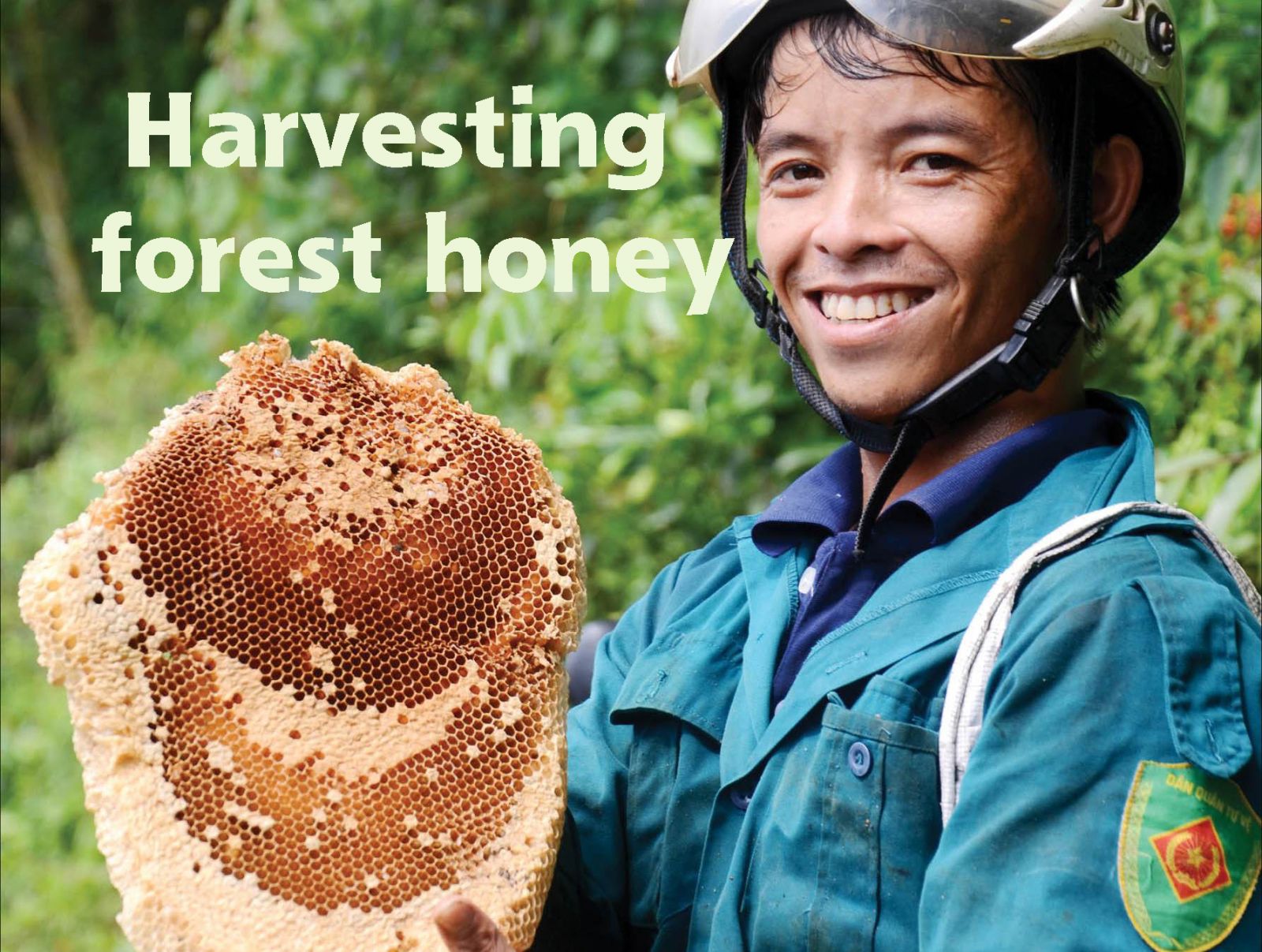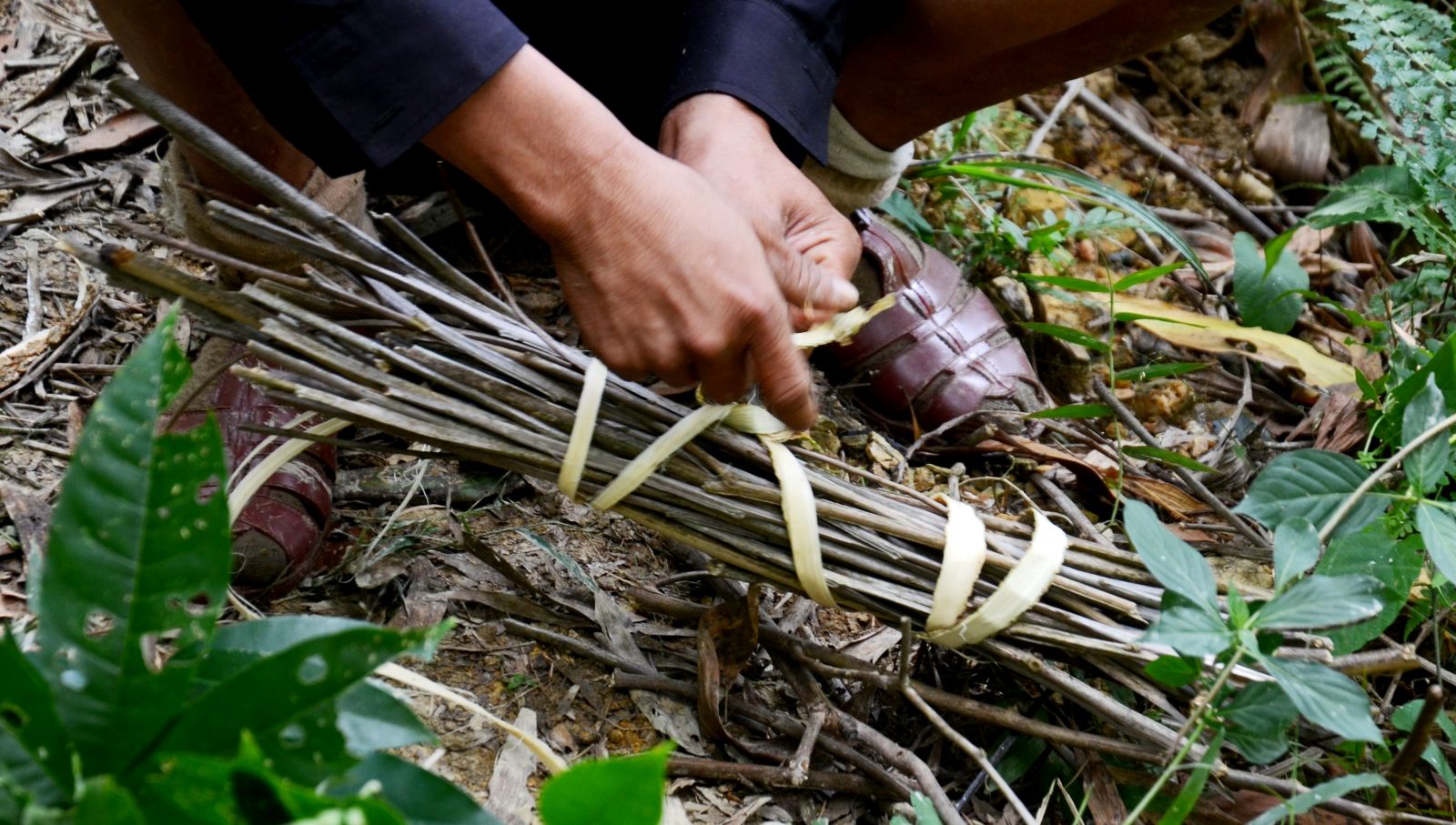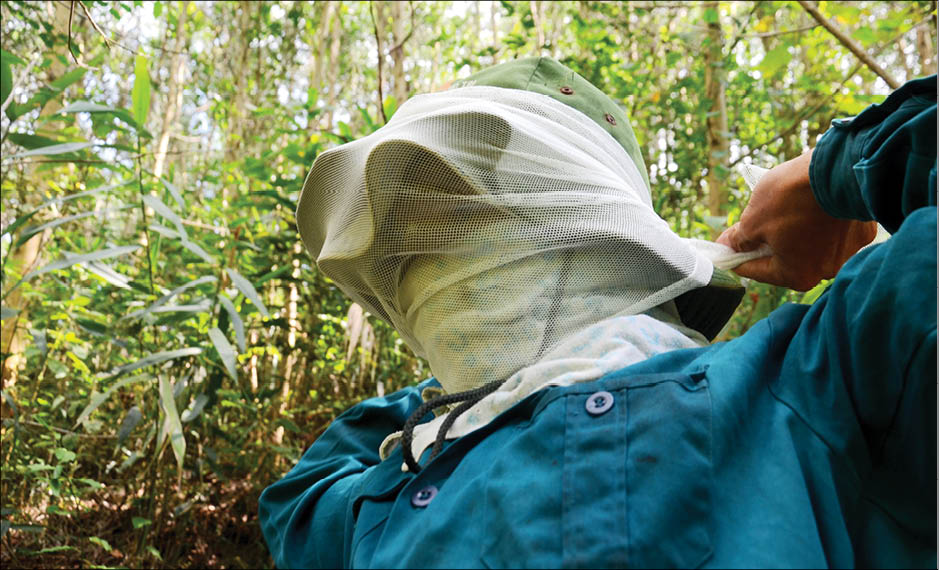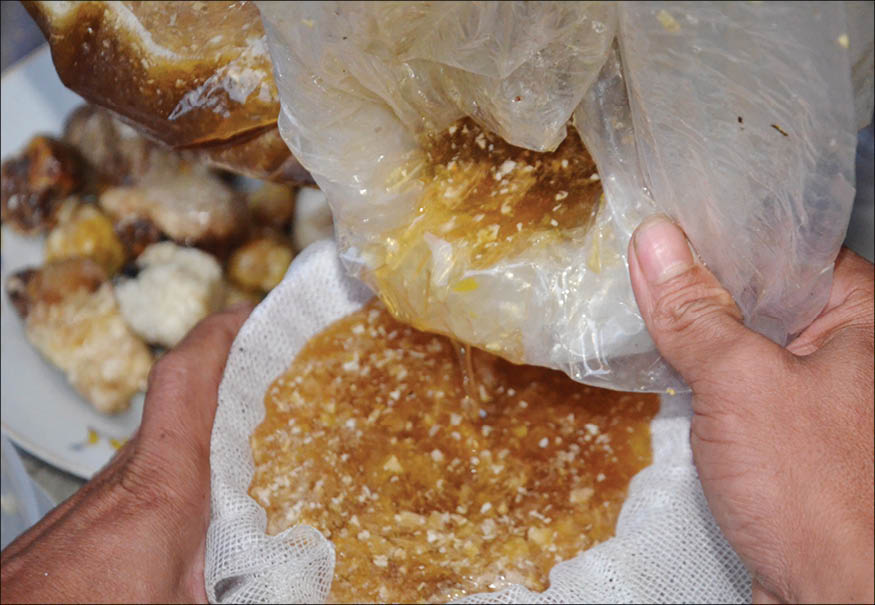
The achievement after a day of hiking through the forest
While farmed honey costs around VND 130,000 to 180,000 per liter, the price of forest honey can reach up to VND 500,000 to 600,000 per liter. In one year, depending on his diligence, a honey harvester can harvest from 100 - 200 liters of honey...
Following the forest honey harvesters, it took about 15 minutes by motorbike to go from the People's Committee of Duong Hoa Commune (Huong Thuy Town) to the acacia and melaleuca/cajuput forests in the Bay Mo area. That was just to the edge of the forest. To go to the area that honey bees build hives, the honey harvesters must hike across streams and hills for an hour. From this area, they spread out in many directions. Some went deeper into the forest. As they walked, they carefully watched the streamlet under their feet; their hands clasped to block the sun rays as they looked up to the tree tops.

"Đằng" is used by the honey harvester as a ladder to help them climb easily
Honeybees often nest near the streams. “Bees ‘landing’ on the water (drinking water) is a signal that a hive is nearby,” said Luyen as he watched the black and yellow striped honey bee as large as the tip of his little finger flying round in the dazzling sun after having a drink. I was about to ask him a question when he quickly grabbed the carry basket. His eyes looked towards the tree tops as he hurriedly followed the bee despite the forest vines and thorns constantly hitting and dangling onto his body.
After 15 minutes up, Luyen stopped, fingers pointing to the tree top far away. He shook his head saying that the hive was too small, with possibly 250ml of honey. He said he would leave it for some other day. "Apart from streams, honey bees often choose trees which have many large horizontal branches and enough room to build a hive. In such a place, the hive can avoid wind and it makes it easier for the bees to return after drinking water or collecting nectar.”
At this time, a few brief and long howls from far away were heard. Turning around to look at me, his companion, who was heavily breathing through... the mouth, Luyen laughed, saying that I was already tired; and that we should take a rest. The siblings Lien and Lai reported that there were no hives around there, so they would go to Ca stream to search.

Using dried branches as a smoke torch
The Ca stream was about 10km from where Luyen and his team were. "When the season comes, bees from the forests of Laos fly over here to avoid the rain, making countless hives. For those who are hardworking and go deep in the forest, harvesting tens of liters of honey a day is possible. If you’re empty handed in a particular day, you would still be sure to make up for it the following day. Basically, it’s going to worth your while,” Luyen said.
Normally, there are two seasons for harvesting honey: from February to March and June to September of the lunar calendar. Honey harvesters take a break during the rainy season. But this year, the weather is abnormal. “Usually, it should be raining now, but it’s scorching these days. Bees from Laos are still flying over so we are taking advantage of the situation to get some final hives of the season,” the little boy called Neo said as he used a branch to scrape off a leech the size of his little finger, wriggling in the pile of decayed leaves.
After getting rested, our group continued to go through the forest. After following Luyen and Neo for more than one more hour, apart from seeing traces of a huge hive on a large 10m-high branch that was... already harvested by another group, there was no hive to be seen. “This hive must have had about 4 to 5 liters of honey. It’s unfortunate that we’re late. You see the "đằng" over there? That’s the tool we honey harvesters use to help us climb more easily and safely when we encounter a hive that is on a tall and big tree,” Luyen said.
A smoke torch made from dried branches and fresh leaves create a lot of smoke to scare away the bees
The "đằng" that Luyen referred to is a short branch attached to the tree trunk that the bees made their hive. The branch is tied by forest vines and has a function similar to that of a ladder. It helps harvesters to climb trees that are too big or too tall. This type of equipment is often created on the spot, using the branches and vines found in the forest, since the tools they brought along are very simple, including an ax, a mesh mask, a mesh cloth and some bottles and clean plastic bags to hold the honey. All are put in a carry basket or a small bag.

Protecting the face with a mesh cloth
Three hours passed in fatigue and disappointment. Suddenly, the buzzing sound of bees echoed across the shallow water. Ten minutes later, under the 8m-high cajuput trunk, a hive swarming with black bees dangled in the wind. Luyen put down his carry basket and cheerfully said, “I thought we wouldn’t find a hive today. We’re lucky to find this one. This would be enough for the day’s work for us two.”
Then, Luyen and Neo found vines to tie together dry branches and cover with fresh leaves. They braided it into the torch with a hook on the top. “The fire from dry leaves and branches will burn the fresh leaves, creating smoke. The smoke will chase away the bees. The hook will attach the torch to the tree branch while we harvest the honey,” Neo explained.
.jpg)
In order to get the honey, the harvester must be brave
The contents in the carry basket were taken out. After a few minutes, Luyen was covered from head to toe. He held the smoking torch in one hand. Like a squirrel, he quickly climbed the tree and got close to the hive, ignoring the weight of his body on the bending branch. After a while, the smoke got into the hive. Thousands of bees swarmed out creating a black cloud. At this moment, Neo pulled his reporter companion who was still immersed with the camera below to a large tree that was quite far away and made a notion to stay still: “A couple of bee stings are manageable but a few hundred or thousand bees attacking us would be a big problem.”
Eyes on the top of the tree, even though the mesh over his face was now covered black with bees, Luyen calmly used his hand to tear the lower layer (where young bees nest). Then, he used his knife to cut the honeycomb into the plastic bag and quickly climbed down. After carefully extinguishing the torch in the nearby stream, Luyen laughed: “This is around 1 liter. It’s almost dark now. Let’s go home. If it is clear tomorrow, we’ll go deeper in the natural forest. Chances are better there.”

Luyen’s full name is Truong Huu Luyen. Despite his young age (he was born in 1985), Luyen is currently the local Party Secretary and the head of Thanh Van Village and a member of the People's Committee of Duong Hoa Commune.
On the way back, Luyen said that about 90% of people in Duong Hoa commune make a living by forest plantation and harvesting honey is one of the extra jobs of many people here while waiting for harvest from planted forests.

Luyen and his brother also follow the honey harvesting job
It was getting dark by the time we stepped out of the edge of the forest. Arriving home, Luyen and Neo took out the honeycomb and performed the last step: squeezing the honey to store in glass bottles and wait for the buyer. As he squeezed the honey on top of a mesh cloth to strain out the impurities, Neo told me the way to distinguish between forest honey and farmed honey. He said that apart from a stronger taste, one liter of forest honey would weigh over 1.3 kg, and for the farmed honey, the weigh is about 1.2kg / liter. “To know if the honey is pure or not, just take a sheet of paper and drop a drop of honey on top. If the honey is absorbed into the paper, or if it spreads quickly, then the honey is mixed with sugar.” He also said that honey should only be kept for about a year and a half. If kept for too long, the honey will turn dark and its sweetness and nutritional value will decrease noticeably.
At 5 o'clock, Lai and Lien came home. Both were pretty happy with the honey they harvested. “In season, harvesting this much is normal for a day’s work. But usually, at the same time in previous years, this is supposed to be the rainy season. The bees stay in Laos. So, harvesting 4 liters of honey now is really good already,” Lien said while quickly squeezing out all the honey and taking the remaining clumps of honeycomb to soak in alcohol.

Straining the honey before bottling
"Honey in the off-season is more likely to sell higher. But even in season, if you’re hardworking and willing to go deep into the forest, accepting the danger of poisonous snakes, leeches, wild bees, and falling off broken branches when climbing trees, then income from honey and alcohol can help cover many expenses,” Lien smiled; his hands holding the sweet, fragrant gift of nature; his eyes filled with gratitude.